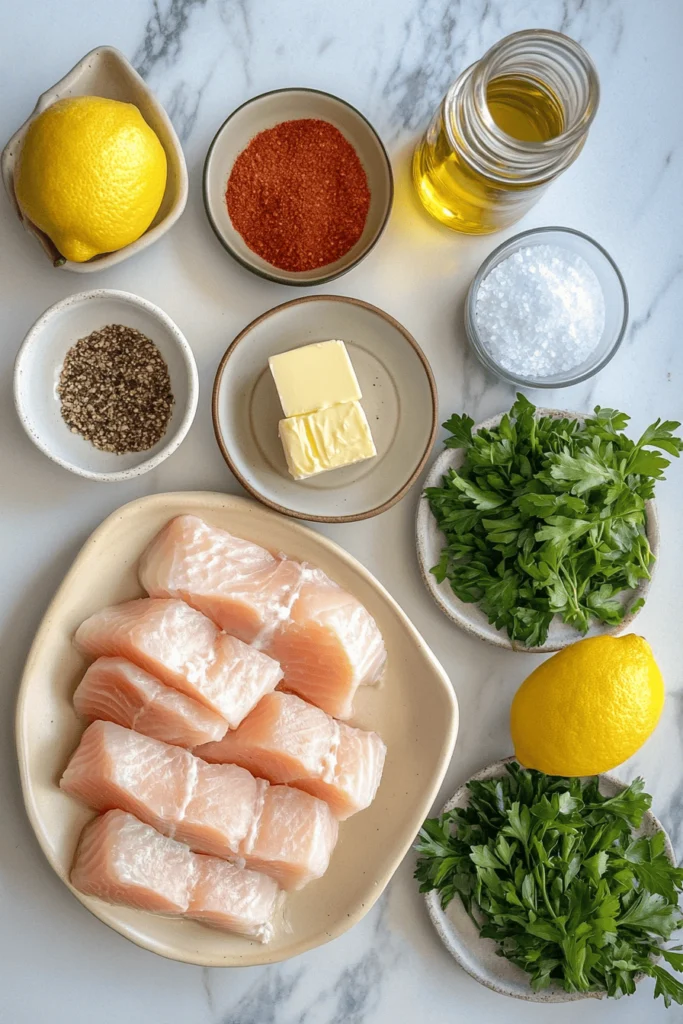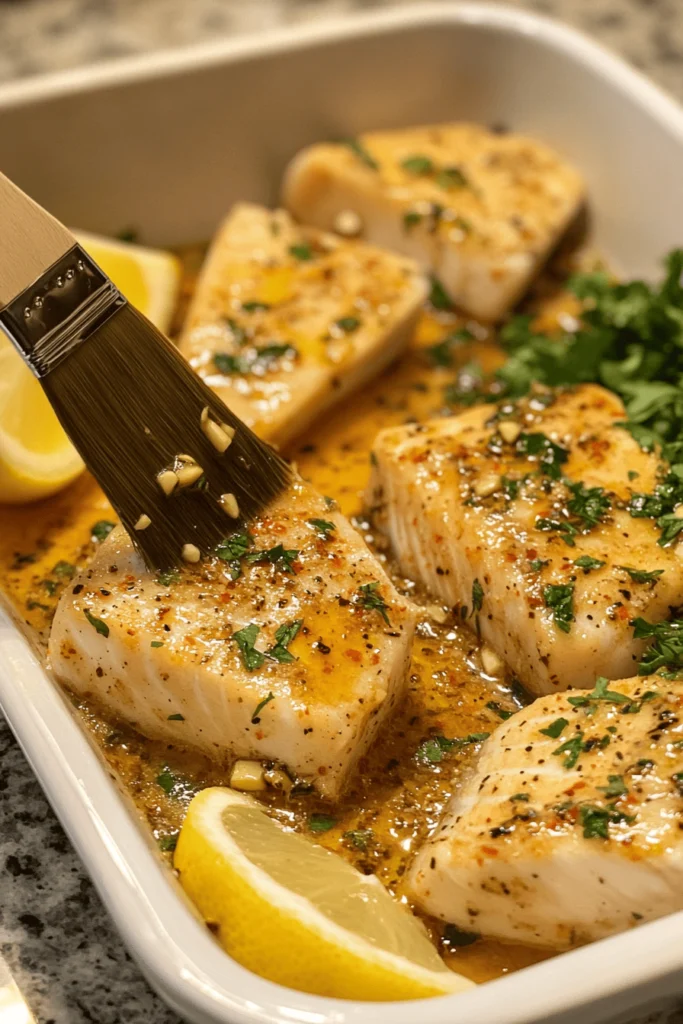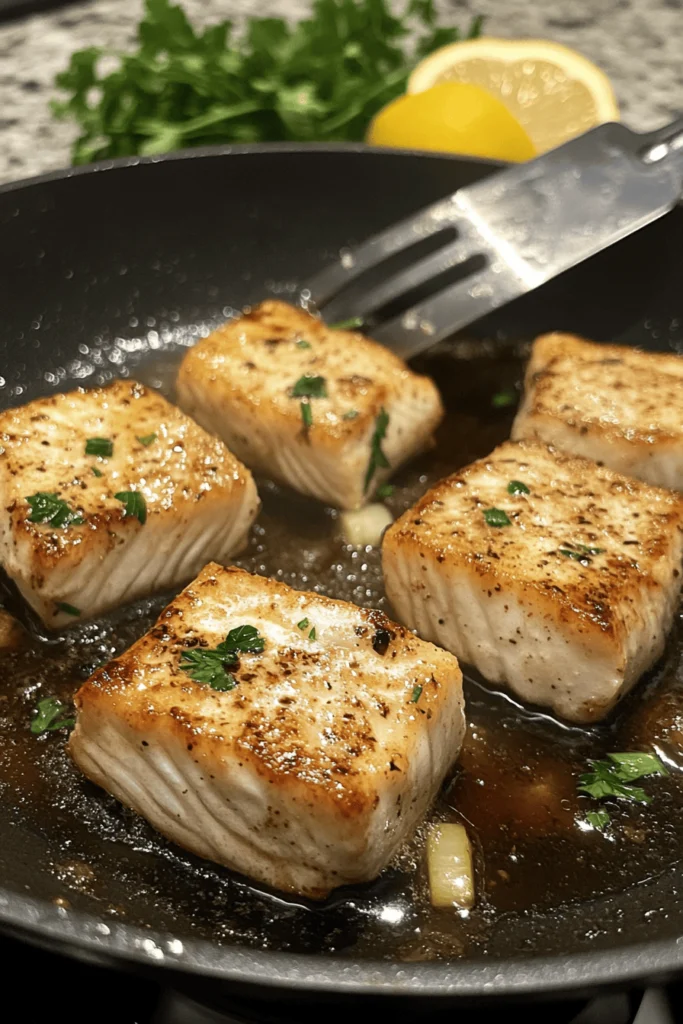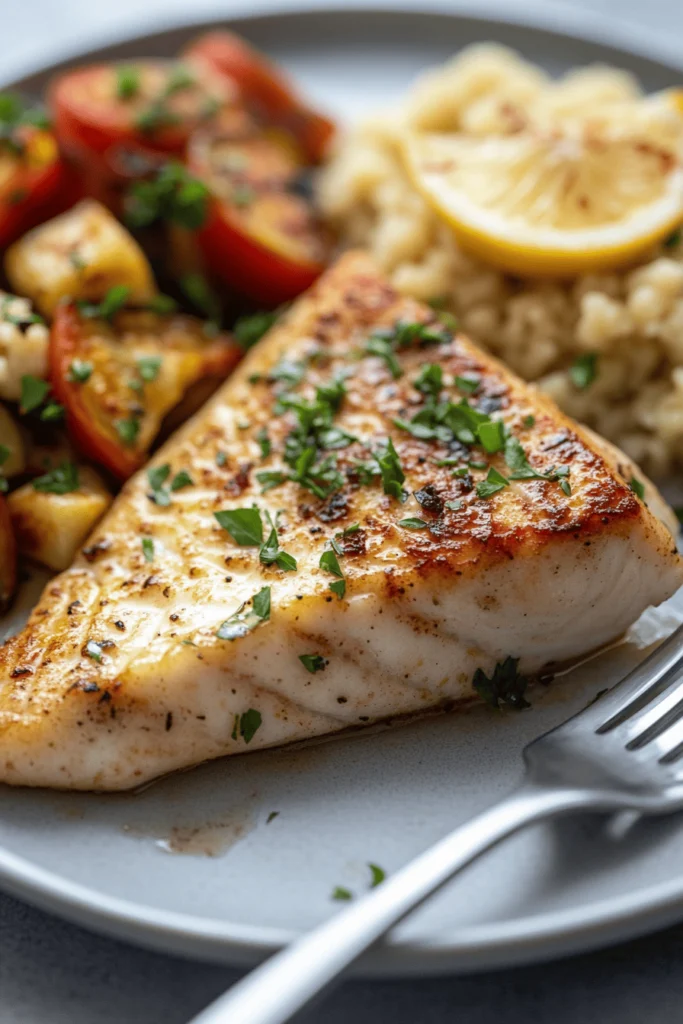Table of Contents
A gray, rainy afternoon pushed me to try a swordfish fillet I’d just picked up at the market. Its firm, briny aroma called for a bright trio of lemon, herbs, and a smoky dash of paprika. One quick sear later, the steak was tender and citrus-kissed—proof that a home cook can plate restaurant-worthy flavor. Here’s the simple recipe that turned a quiet day in the kitchen into a delicious discovery.
Key Benefits of a Swordfish Recipe
- High in Essential Nutrients
Swordfish is packed with lean protein and omega-3 fatty acids, promoting heart health and supporting balanced cholesterol levels. It also contains vitamins such as B12, which helps with red blood cell production and overall energy. - Deliciously Versatile
Whether you enjoy grilling, baking, or pan-searing, swordfish adapts exceptionally well to various cooking methods. Its firm, steak-like texture provides an excellent backdrop for zesty lemon-pepper flavors or rich garlic-butter sauces. - Fits a Balanced Lifestyle
With its robust protein content and relatively low fat, swordfish is ideal for anyone looking to manage weight or build muscle. Pair it with vibrant vegetables, wholesome grains, or crisp salads to keep meals hearty yet healthy. - Quick and Convenient
Despite its impressive appearance, swordfish remains easy to prepare. It doesn’t flake or fall apart like many delicate fish, making it a user-friendly option for seafood newcomers. - Elevates Everyday Dining
The dense texture and unmistakable savoriness of swordfish bring a restaurant-quality feel to routine meals. Serving it at gatherings or dinner parties tends to leave a lasting impression on guests.
Ingredients
Below is a straightforward list of ingredients you’ll need for this swordfish recipe:
| Ingredient | Quantity | Notes |
|---|---|---|
| Swordfish fillets | 2 (6–8 oz each) | Opt for fresh or a high-quality frozen option. |
| Olive oil | 2 tablespoons | Extra virgin for a bolder flavor. |
| Lemon juice | 2 tablespoons | Freshly squeezed to elevate taste. |
| Garlic (minced) | 2 cloves | Adds warmth and depth to the dish. |
| Paprika | 1 teaspoon | Infuses a mild, smoky hint. |
| Salt | ½ teaspoon | Adjust according to personal preference. |
| Black pepper | ½ teaspoon | Freshly ground for enhanced aroma. |
| Dried oregano | ½ teaspoon | Herbaceous note that blends well with tangy flavors. |
| Unsalted butter (optional) | 1 tablespoon | Contributes richness if you desire a creamier finish. |
| Chopped parsley (optional) | 1 tablespoon | Sprinkling on top for freshness and color. |

Notes on Ingredient Selection
- Prioritize Freshness
Whenever you can, choose swordfish with a mild odor and a firm texture. If fresh isn’t available, thaw your frozen fillets thoroughly in the fridge for best flavor and consistency. - Flavor Tweaks
Want extra heat? Sprinkle some chili powder or cayenne pepper into the marinade. Swordfish has a bold flavor of its own, so be mindful not to overpower it. - Butter vs. Oil
For a lighter take, omit butter and rely solely on olive oil. You’ll still achieve a savory, mouthwatering profile without added richness.
Step-by-Step Instructions
Preparing this swordfish recipe can be both uncomplicated and rewarding if you follow a few key techniques. Below are three main steps, along with recipe variations, to guide you from start to finish.
Step 1: Preparation
- Gather Your Tools
Before you begin, ensure you have all your cooking essentials within reach. A sharp knife, a sturdy cutting board, measuring spoons, a bowl for mixing the marinade, and either a skillet or a baking dish are your primary needs. - Combine Seasonings
In a bowl, whisk together olive oil, lemon juice, minced garlic, paprika, salt, black pepper, and dried oregano. If you plan to use butter, melt it in a microwave-safe dish or small saucepan, then blend it into the mixture. This creates a flavorful marinade that infuses each bite of swordfish with zest and richness. - Marinate the Fillets
Pat the swordfish fillets dry with a paper towel. Eliminating excess moisture helps the marinade adhere to the surface and deliver a vibrant flavor. Arrange the fillets in a shallow dish or a large resealable plastic bag, then pour the marinade over them. Flip each piece gently to coat both sides, seal or cover, and place in the refrigerator for about 15 to 20 minutes. While a longer marination can deepen the taste, even a short soak imparts a delightful flavor.

Step 2: Cooking Process
- Choose Your Cooking Method
- Pan-Searing: Preheat a skillet over medium-high heat for roughly two minutes. Add a drizzle of olive oil. Cook each marinated swordfish fillet for about 4 to 5 minutes per side, or until it flakes easily when tested with a fork.
- Baking: Preheat your oven to 375°F (190°C). Arrange the fillets on a greased or parchment-lined baking sheet, spooning any extra marinade on top. Bake for 15 to 20 minutes, checking on them near the 15-minute mark.
- Grilling: If grilling, heat the grill to medium-high and lightly oil the grates. Cook each side for approximately 4 minutes, adjusting time based on your grill’s intensity. Turn the fillets carefully to keep the flesh intact.
- Monitor Internal Temperature
For safety and optimal texture, make sure the internal temperature of the fish reaches at least 145°F (63°C). Using a reliable food thermometer helps you avoid overcooking and drying out the swordfish. - Check Appearance and Aroma
Properly cooked swordfish should turn opaque and flake when pressed lightly. You’ll detect a pleasant, subtly sweet aroma that signals it’s ready to plate.

Step 3: Finishing Touches
- Add Garnishes
When the fillets are finished, move them onto a serving platter. If you choose fresh parsley, sprinkle it on top for a burst of color and fresh fragrance. A quick squeeze of lemon juice before serving can also brighten the overall flavor. - Taste and Adjust
Sample a small piece to confirm you’re happy with the seasoning. If you find it needs more tang, a dash of lemon juice or a bit more black pepper can make a noticeable difference. - Keep It Warm
If you’re cooking multiple batches, place the prepared fillets in a low-heat oven (about 200°F or 93°C) to maintain warmth until serving.

Recipe Variations
Swordfish is inherently adaptable, so feel free to try these different spins on the traditional version:
- Tropical Twist
Marinate the fillets with a blend of pineapple juice, lime juice, and a sprinkle of chili powder. This island-inspired combination offers a sweet-and-tangy burst with a gentle kick. - Herb-Infused Delight
Swap paprika for fresh rosemary and thyme to achieve a rustic, woodsy profile. Drizzle extra olive oil on top before baking to lock in moisture. - Lemon-Pepper Zing
If you love bright citrus notes, grate a bit of fresh lemon zest into your marinade. Pair that tangy zest with a heavier dose of black pepper for a lively flavor that complements swordfish perfectly. - Garlic-Parmesan Crust
For a richer meal, top each fillet with minced garlic and a layer of Parmesan cheese. Bake until the crust becomes lightly golden and crisp.
No matter which variation you explore, swordfish’s robust texture and satisfying taste will shine through. This adaptability makes it simple to customize the recipe to your personal preferences, the season, or any special dietary needs.
Serving Suggestions
Once you’ve mastered your swordfish recipe, pairing it with the right sides and drinks can greatly enhance your meal:
- Vibrant Vegetable Medleys
Roast zucchini, bell peppers, and onions until they’re lightly caramelized. A sprinkle of salt and a drizzle of olive oil bring out their natural sweetness, creating a lovely contrast to the savory nature of swordfish. - Nutritious Grains
Quinoa, brown rice, or couscous provides a satisfying base that easily soaks up extra marinade. If you prefer a lighter dish, consider incorporating steamed greens or finely chopped herbs into your grains for more color and flavor. - Refreshing Salads
Complement the fish with a crisp, leafy salad. Combining romaine lettuce, cherry tomatoes, cucumbers, and a tangy dressing highlights the ocean-fresh brininess of swordfish while keeping the meal bright. - Flavorful Sauces
A mild yogurt-based dressing or a quick lemon-garlic aioli can lend a creamy note without overshadowing the fish. If you love bolder tastes, blend basil or cilantro with olive oil and a bit of lemon juice to make a simple homemade pesto. - Beverage Tips
Light, invigorating beverages harmonize well with swordfish. Sparkling water infused with citrus or fresh mint can help cleanse the palate, ensuring you catch every nuance of flavor in each bite.
Tips for Success
Cooking swordfish can be delightfully straightforward, provided you pay attention to the details that preserve its taste and texture:
- Monitor the Heat
Aim for an internal temperature of about 145°F (63°C) to avoid drying out the fillet. A digital thermometer is your best friend in ensuring perfectly cooked swordfish. - Moderate Marination
While marinating helps incorporate flavors, soaking swordfish for too long might soften its dense, meaty texture. Typically, 20–30 minutes is enough to achieve a robust taste. - Season to Your Preference
Swordfish’s hearty profile absorbs seasonings exceptionally well. Feel free to add more spice or a variety of herbs like thyme, rosemary, or oregano, to cater to your palate. - Keep an Eye on Time
Whether you choose to bake, grill, or pan-sear, watch cooking durations closely. A quick check a few minutes before the suggested cook time ends can help prevent overcooking. - Use Fresh Ingredients
Whenever possible, go for the freshest produce, herbs, and oils. These essential choices can transform an ordinary dish into a memorable feast.
Mastering the Art of Seafood
Cooking a meaty fish like swordfish can significantly elevate your home-cooked repertoire. Here are some key points to consider:
- Choose Quality
Opt for fillets that have a clean, mild smell and a firm feel. High-quality fish is the backbone of any successful swordfish recipe. - Mind Cooking Methods
Baking, grilling, or pan-searing each brings out different facets of swordfish. Experiment to see which method suits your taste and comfort level in the kitchen. - Experiment with Pairings
Keeping side dishes simple allows the fish to remain the star of the plate. On the other hand, bright sauces, dips, or garnishes can add extra intrigue to every bite.
Keeping track of what works well (and what might need tweaking) each time you cook helps refine your technique. Gradually, you’ll gain the confidence to swap ingredients and explore new twists without hesitation.
Frequently Asked Questions (FAQ)
Although the main dish features wordfish, here are some popular queries about Swordfish, another meaty fish enjoyed in similar ways.
What are the best Swordfish recipes?
Swordfish works well with marinades like garlic-butter or spicy Cajun rubs. You can also bake it with herbs or grill it using citrus-infused seasonings. Its dense texture handles diverse flavor profiles with ease.
How do you make grilled Swordfish?
Combine oil, lemon juice, and seasonings, salt, pepper, perhaps some garlic powder, then let the fillet sit in this mixture briefly. Place it on a preheated medium-high grill for about 4–5 minutes per side, or until it reaches an internal temperature of 145°F (63°C).
What is the easiest way to cook Swordfish?
Pan-searing is one of the simplest. Warm a drizzle of olive oil in a skillet over medium-high heat. Season your steak with salt and pepper, cook each side for roughly 4–5 minutes, and finish with a squeeze of lemon.
Can you cook rare Swordfish?
While some chefs prepare swordfish similarly to tuna, slightly undercooked food safety guidelines typically advise cooking fish to 145°F (63°C). If you opt for rare swordfish, ensure you have high-quality, sushi-grade fish.
What does a baked Swordfish taste like?
Baked swordfish develops a firm, slightly sweet taste, often compared to that of lighter cuts of meat. The right blend of spices and cooking times can highlight its mild, savory essence.
How do you cook a swordfish steak in the oven?
Preheat your oven to 375°F (190°C). Lightly coat the steak in oil, add seasonings of choice, and arrange it on a baking sheet. Cook for 15–20 minutes, checking regularly until it reaches a safe internal temperature.
Conclusion
A thoughtfully prepared swordfish recipe strikes the perfect balance between convenience, nourishment, and creativity. Choosing fresh ingredients, observing moderate cook times, and pairing your fillets with balanced sides can yield a seafood feast that easily competes with high-end restaurant dishes. At the same time, exploring other meaty fish varieties reminds us that the world of seafood offers endless flavors and textures. With each new experience in your kitchen, your culinary skills and self-assurance will only grow, proving that a simple, well-executed recipe has the power to transform an ordinary meal into a truly remarkable occasion.
Print
Swordfish Recipe
- Total Time: 25 minutes
- Yield: 2 servings 1x
- Diet: Gluten Free
Description
Golden, buttery, and infused with the perfect balance of garlic and citrus, this Garlic Butter Pan-Seared Swordfish is a restaurant-quality dish you can make at home in under 30 minutes! With a crispy, golden crust and a juicy, tender center, this swordfish recipe is a guaranteed hit for seafood lovers. Serve it with a side of roasted vegetables or a fresh salad for an easy yet elegant meal.
Ingredients
For the Swordfish:
- 2 swordfish fillets (6–8 oz each, about 1 inch thick)
- 1 teaspoon salt
- ½ teaspoon black pepper
- 1 teaspoon paprika
- ½ teaspoon dried oregano
- 1 tablespoon olive oil
For the Garlic Butter Sauce:
- 2 tablespoons unsalted butter
- 3 cloves garlic, minced
- 2 tablespoons lemon juice (freshly squeezed)
- 1 tablespoon chopped fresh parsley (for garnish)
Instructions
Prep the Swordfish:
- Pat the swordfish fillets dry with paper towels.
- Season both sides evenly with salt, black pepper, paprika, and oregano.
Sear the Swordfish:
- Heat olive oil in a large skillet over medium-high heat.
- Once the oil is shimmering, carefully add the fillets.
- Sear for 4–5 minutes per side or until a golden-brown crust forms and the fish flakes easily with a fork.
Make the Garlic Butter Sauce:
- Reduce heat to medium and push the swordfish to the side of the pan.
- Add butter and let it melt. Stir in garlic and cook for about 30 seconds until fragrant.
- Pour in lemon juice, stirring to combine.
Baste & Finish:
- Spoon the garlic butter sauce over the swordfish fillets.
- Let the fillets cook for another 1–2 minutes, ensuring they reach an internal temperature of 145°F (63°C).
Serve & Enjoy:
- Transfer the fillets to a serving plate.
- Drizzle any remaining sauce over the top.
- Garnish with fresh parsley and serve with lemon wedges.
Notes
✔ Fresh vs. Frozen Swordfish: If using frozen fillets, thaw them overnight in the refrigerator and pat them dry before seasoning.
✔ Don’t Overcook! Swordfish can dry out quickly—use a meat thermometer to check for 145°F (63°C).
✔ Pairing Suggestions: Serve with roasted asparagus, quinoa, or a fresh citrus salad for a balanced meal.
✔ Make it Spicy: Add a pinch of red pepper flakes for a little heat!
- Prep Time: 10 minutes
- Cook Time: 15 minutes
- Category: Main Course
- Method: Pan-Searing
- Cuisine: Mediterranean, American
Nutrition
- Serving Size: 1 swordfish fillet
- Calories: 320 kcal
- Sugar: 0g
- Sodium: 500mg
- Fat: 18g
- Carbohydrates: 2g
- Protein: 36g
Keywords: swordfish recipe, pan-seared swordfish, garlic butter fish, easy seafood recipe, Mediterranean swordfish, healthy fish dinner, low-carb fish recipe, gluten-free seafood


1 thought on “Swordfish Recipe”